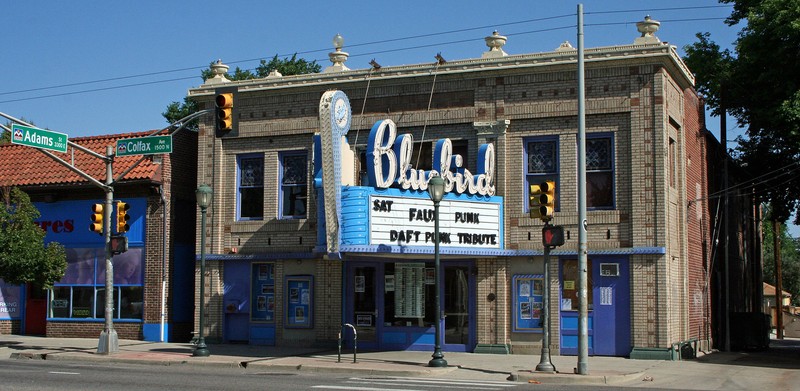The Bluebird Theatre
Introduction
Text-to-speech Audio
This historic Denver theater was constructed in 1913 and was originally known as the Thompson Theatre. During the early 20th century, this was one of a dozen neighborhood movie theaters in the area. Theatre mogul Harry Huffman purchased the facility in 1921. By the 1930s, competition from larger theaters and the effects of the Great Depression led to innovation in promotions that included giveaways of essential items and financial support through partnerships and sponsorships with area banks and businesses. By the 1970s, much of the theater's brick and terra cotta were covered with wood and many of the windows were also covered, a reflection of the transition from showing first-run Hollywood films to families to the theater's transition to showing X-rated films. Thankfully, the building was restored to match its original appearance thanks to the efforts of preservationists and neighborhood boosters and reopened in 1994 as an intimate and lively venue for many local and national bands. While the original projection room remains, much of the interior has changed to accommodate live music. The balcony features chairs that were brought to the Bluebird from Beth Ha Medrosh Hagodol Synagogue in Denver.
Images
The Bluebird Theatre dates back to the early 1900s and was restored in the 1990s

Backstory and Context
Text-to-speech Audio
Harry W.J. Edbrooke designed the theater which opened and operated at a time when there were numerous other small theaters on Colfax owing to its location on the streetcar line. Edbrooke is known for his work on the Denver Gas & Electric Building and the First National Bank. The building is a two-story rectangle structure with a light tan brick with red terra cotta accents. The theatre also features its signature lighted marquee. Visitors to the theater can still find the initials JT on the building for the original owner John Thompson.
In 1921, Harry Huffman, a theatre mogul, purchased the theater and it was at that time that the Thompson Theatre was named The Bluebird. During WWII, Huffman offered War Bonds to patrons who filled his seats. Huffman established a contest between all his theaters, to see who could sell the most bonds. The Bluebird took first place. After WWII, the theatre entered a difficult period where it could no longer afford to acquire and show the productions of leading theaters. Instead, the theater acquired and played an assortment of low-budget productions to an increasingly declining audience. By the 1970s it began showing adult films. The movie theatre closed in 1987.
In 1994 Chris Swank and Evan Dechtman purchased the Bluebird. Thanks in part to federal support, the pair renovated the theater and added tiered levels and a bar to support live music. AEG took over the property in 2006. Since reopening as a music venue, many contemporary musicians have graced the stage. Amongst locals, this theater is known for its acoustic qualities unique to a small venue.
Cite This Entry
Adkins, Alan and Clio Admin. "The Bluebird Theatre." Clio: Your Guide to History. August 13, 2022. Accessed April 14, 2025. https://theclio.com/entry/155564
Sources
- Noel, Thomas J. Bluebird Theatre's Blue Nights, Denver Public Library. September 30th 2012. Accessed July 18th 2020. https://history.denverlibrary.org/news/bluebird-theaters-blue-nights.
- Venue Info, The Bluebird Theatre. Accessed July 18th 2020. https://www.bluebirdtheater.net/venue-info.
- The Bluebird Theatre, History of Colorado. Accessed July 18th 2020. https://www.historycolorado.org/location/bluebird-theater.
- Bauer, Kimberly . The Bluebird, Pedaling Preservation. January 24th 2015. Accessed July 22nd 2020. https://pedalingpreservation.wordpress.com/2015/01/24/bluebird-theater/.
- Register Form, National Register of Historic Places. Accessed July 22nd 2020. https://npgallery.nps.gov/NRHP/GetAsset/1ac13bd5-d962-4abe-b072-bb283c517605/.
Photo by Jeffrey Beall, https://en.wikipedia.org/wiki/Bluebird_Theater#/media/File:Bluebird_Theater.JPG

